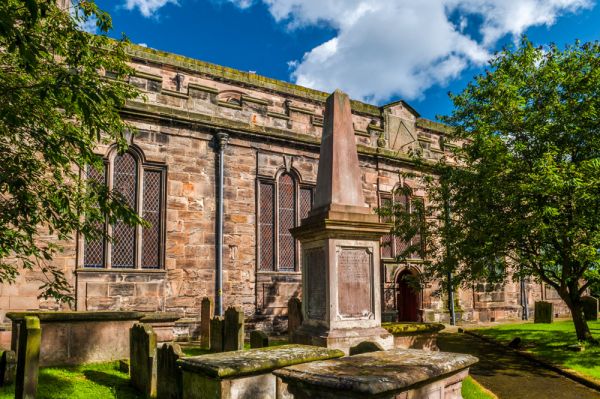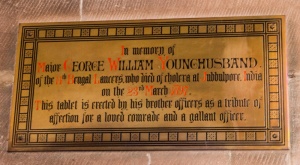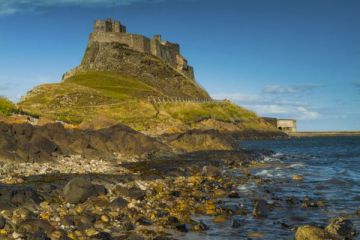
Very few new churches were built in England during Oliver Cromwell's Commonwealth (1649-1660). Holy Trinity church in Berwick-upon-Tweed is one, though in a curious twist it owes its existence to Cromwell's foe, King Charles I.
In 1641 the beleaguered king gave money for a new church in Berwick to replace a medieval building that had fallen into disrepair. Despite the outbreak of the Civil War, even more money was raised from local citizens, and in 1650 John Young of London was hired to build the new church.
Young's church was built using stone from Berwick's medieval castle, and was completed by 1652. The new church was inspired by the design of St Katherine Cree in London, which would have been familiar to Young. There is a long, low nave with aisles either side, reached through arcades of the Tuscan order. Unusually for an English parish church, there was no chancel, no tower, no bells, no organ, and no altar. Extra seating was provided by inserting galleries on all four sides.

The church was consecrated in 1662 by Bishop John Cosin of Durham, who stipulated that a chancel should be added to hold a communion table. His command was obeyed ... 255 years later, when a chancel in neoclassical style was added to the east end of the nave. The original 1662 communion table is still in use, and at the east end of the chancel is a reredos designed by Sir Edwin Lutyens.
The 1855 restoration also included new classically-inspired windows to replace the original Gothic designs. A large west window was inserted, with 16th-17th century Flemish glass brought from the Duke of Buckingham's private chapel at Canons Park, near London.
The organ is nominally of 1773 date, though it was extensively rebuilt in 1855, 1869, 1928, and 2010.
The church stands in a beautifully wooded churchyard, which has been declared a nature reserve. In the churchyard are fascinating graves including those to plague victims and ancient Viking grave markers. Inside the church itself, look for a memorial to Major George Younghusband, who died of cholera in 1897 while serving in India.
Curiously, the church still has no bells, so the bells of the nearby town hall are rung instead.
Holy Trinity's parish is the most northerly in England, and extends north of the River Tweed to the Scottish border. The parish boundary is the same as the ancient Liberties of Berwick. In an annual ceremony dating back centuries, the parish boundaries are ridden on horseback each year. The church is usually open to visitors during daylight hours, and is well worth taking the time to explore.
Directly opposite the churchyard is the entrance to the 1721 Berwick-upon-Tweed Barracks, one of the earliest purpose-built military barracks in the country.
About Berwick-upon-Tweed, Holy Trinity
Address: Parade,
Berwick-upon-Tweed,
Northumberland,
England, TD15 1DF
Attraction Type: Historic Church
Location: On Parade, opposite Berwick Barracks. Normally open to visitors daily.
Website: Berwick-upon-Tweed, Holy Trinity
Location
map
OS: NU000532
Photo Credit: David Ross and Britain Express
HERITAGE
 We've 'tagged' this attraction information to help you find related historic attractions and learn more about major time periods mentioned.
We've 'tagged' this attraction information to help you find related historic attractions and learn more about major time periods mentioned.
Find other attractions tagged with:
Iron Age (Architecture) -
NEARBY HISTORIC ATTRACTIONS
Heritage Rated from 1- 5 (low to exceptional) on historic interest
Berwick-upon-Tweed Barracks and Main Guard - 0.1 miles (Historic Building) ![]()
Berwick Castle - 0.4 miles (Castle) ![]()
Paxton House - 4.2 miles (Historic House) ![]()
Union Chain Bridge - 4.3 miles (Historic Building) ![]()
Foulden Tithe Barn - 4.6 miles (Historic Building) ![]()
Ancroft, St Anne's Church - 5 miles (Historic Church) ![]()
Norham Castle - 6.5 miles (Castle) ![]()
Ayton Castle - 6.8 miles (Historic House) ![]()
Nearest Holiday Cottages to Berwick-upon-Tweed, Holy Trinity:
Berwick-upon-Tweed, Northumberland
Sleeps: 8
Stay from: £807 - 4122
Berwick-upon-Tweed, Northumberland
Sleeps: 8
Stay from: £912 - 3007
Berwick-upon-Tweed, Northumberland
Sleeps: 2
Stay from: £396 - 1203
More self catering near Berwick-upon-Tweed, Holy Trinity









